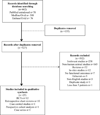Pharmacologic Neuroprotection for Functional Outcomes After Traumatic Brain Injury: A Systematic Review of the Clinical Literature
- PMID: 27339615
- PMCID: PMC5116376
- DOI: 10.1007/s40263-016-0355-2
Pharmacologic Neuroprotection for Functional Outcomes After Traumatic Brain Injury: A Systematic Review of the Clinical Literature
Abstract
Introduction: Traumatic brain injury (TBI) is a major cause of death and disability worldwide. The deleterious effects of secondary brain injury may be attenuated by early pharmacological therapy in the emergency room and intensive care unit (ICU). Current medical management of acute TBI is primarily supportive, aimed at reducing intracranial pressure (ICP) and optimizing cerebral perfusion. There are no pharmacological therapies to date that have been unequivocally demonstrated to improve neurological outcomes after TBI.
Objectives: The purpose of this systematic review was to evaluate the recent clinical studies from January 2013 through November 2015 that investigated neuroprotective functional outcomes of pharmacological agents after TBI.
Methods: The following databases were searched for relevant studies: MEDLINE (OvidSP January Week 1, 2013-November Week 2 2015), Embase (OvidSP 2013 January 1-2015 November 24), and the unindexed material in PubMed (National Library of Medicine/National Institutes of Health [NLM/NIH]). This systematic review included only full-length clinical studies and case series that included at least five patients and were published in the English language. Only studies that examined functional clinical outcomes were included.
Results: Twenty-five of 527 studies met our inclusion criteria, which investigated 15 independent pharmacological therapies. Eight of these therapies demonstrated possible neuroprotective properties and improved functional outcomes, of which five were investigated with randomized clinical trials: statins, N-acetyl cysteine (NAC), Enzogenol, Cerebrolysin, and nitric oxide synthase inhibitor (VAS203). Three pharmacological agents did not demonstrate neuroprotective effects, and four agents had mixed results.
Conclusions: While there is currently no single pharmacological therapy that will unequivocally improve clinical outcomes after TBI, several agents have demonstrated promising clinical benefits for specific TBI patients and should be investigated further.
Conflict of interest statement
Shaun Gruenbaum, Alexander Zlotnik, Benjamin Gruenbaum, Denise Hersey, and Federico Bilotta declare no conflicts of interest.
Figures
Similar articles
-
Elevation of the head during intensive care management in people with severe traumatic brain injury.Cochrane Database Syst Rev. 2017 Dec 28;12(12):CD009986. doi: 10.1002/14651858.CD009986.pub2. Cochrane Database Syst Rev. 2017. PMID: 29283434 Free PMC article.
-
Progesterone for acute traumatic brain injury.Cochrane Database Syst Rev. 2016 Dec 22;12(12):CD008409. doi: 10.1002/14651858.CD008409.pub4. Cochrane Database Syst Rev. 2016. PMID: 28005271 Free PMC article.
-
Systemic pharmacological treatments for chronic plaque psoriasis: a network meta-analysis.Cochrane Database Syst Rev. 2021 Apr 19;4(4):CD011535. doi: 10.1002/14651858.CD011535.pub4. Cochrane Database Syst Rev. 2021. Update in: Cochrane Database Syst Rev. 2022 May 23;5:CD011535. doi: 10.1002/14651858.CD011535.pub5. PMID: 33871055 Free PMC article. Updated.
-
Technological aids for the rehabilitation of memory and executive functioning in children and adolescents with acquired brain injury.Cochrane Database Syst Rev. 2016 Jul 1;7(7):CD011020. doi: 10.1002/14651858.CD011020.pub2. Cochrane Database Syst Rev. 2016. PMID: 27364851 Free PMC article.
-
Antidepressants for pain management in adults with chronic pain: a network meta-analysis.Health Technol Assess. 2024 Oct;28(62):1-155. doi: 10.3310/MKRT2948. Health Technol Assess. 2024. PMID: 39367772 Free PMC article.
Cited by
-
Drugs with anti-inflammatory effects to improve outcome of traumatic brain injury: a meta-analysis.Sci Rep. 2020 Sep 30;10(1):16179. doi: 10.1038/s41598-020-73227-5. Sci Rep. 2020. PMID: 32999392 Free PMC article.
-
Antioxidant thioether core-crosslinked nanoparticles prevent the bilateral spread of secondary injury to protect spatial learning and memory in a controlled cortical impact mouse model of traumatic brain injury.Biomaterials. 2021 May;272:120766. doi: 10.1016/j.biomaterials.2021.120766. Epub 2021 Mar 22. Biomaterials. 2021. PMID: 33819812 Free PMC article.
-
Combination therapy for cerebral ischemia: do progesterone and noscapine provide better neuroprotection than either alone in the treatment?Naunyn Schmiedebergs Arch Pharmacol. 2022 Feb;395(2):167-185. doi: 10.1007/s00210-021-02187-y. Epub 2022 Jan 6. Naunyn Schmiedebergs Arch Pharmacol. 2022. Retraction in: Naunyn Schmiedebergs Arch Pharmacol. 2024 Mar;397(3):1917. doi: 10.1007/s00210-024-02995-y. PMID: 34988596 Retracted.
-
Current and Potential Pharmacologic Therapies for Traumatic Brain Injury.Pharmaceuticals (Basel). 2022 Jul 6;15(7):838. doi: 10.3390/ph15070838. Pharmaceuticals (Basel). 2022. PMID: 35890136 Free PMC article. Review.
-
Neuroprotective Agents in the Intensive Care Unit: -Neuroprotective Agents in ICU.J Pharmacopuncture. 2018 Dec;21(4):226-240. doi: 10.3831/KPI.2018.21.026. Epub 2018 Dec 31. J Pharmacopuncture. 2018. PMID: 30652049 Free PMC article. Review.
References
-
- Lu C, Xia J, Bin W, Wu Y, Liu X, Zhang Y. Advances in diagnosis, treatments, and molecular mechanistic studies of traumatic brain injury. Biosci Trends. 2015;9(3):138–148. - PubMed
-
- Teasdale G, Jennett B. Assessment of coma and impaired consciousness. A practical scale. Lancet. 1974;2(7872):81–84. - PubMed
-
- Gerber LM, Chiu YL, Carney N, Hartl R, Ghajar J. Marked reduction in mortality in patients with severe traumatic brain injury. J Neurosurg. 2013;119(6):1583–1590. - PubMed
-
- Marmarou A, Lu J, Butcher I, McHugh GS, Mushkudiani NA, Murray GD, et al. IMPACT database of traumatic brain injury: design and description. J Neurotrauma. 2007;24(2):239–250. - PubMed
Publication types
MeSH terms
Substances
Grants and funding
LinkOut - more resources
Full Text Sources
Other Literature Sources
Medical
Miscellaneous


